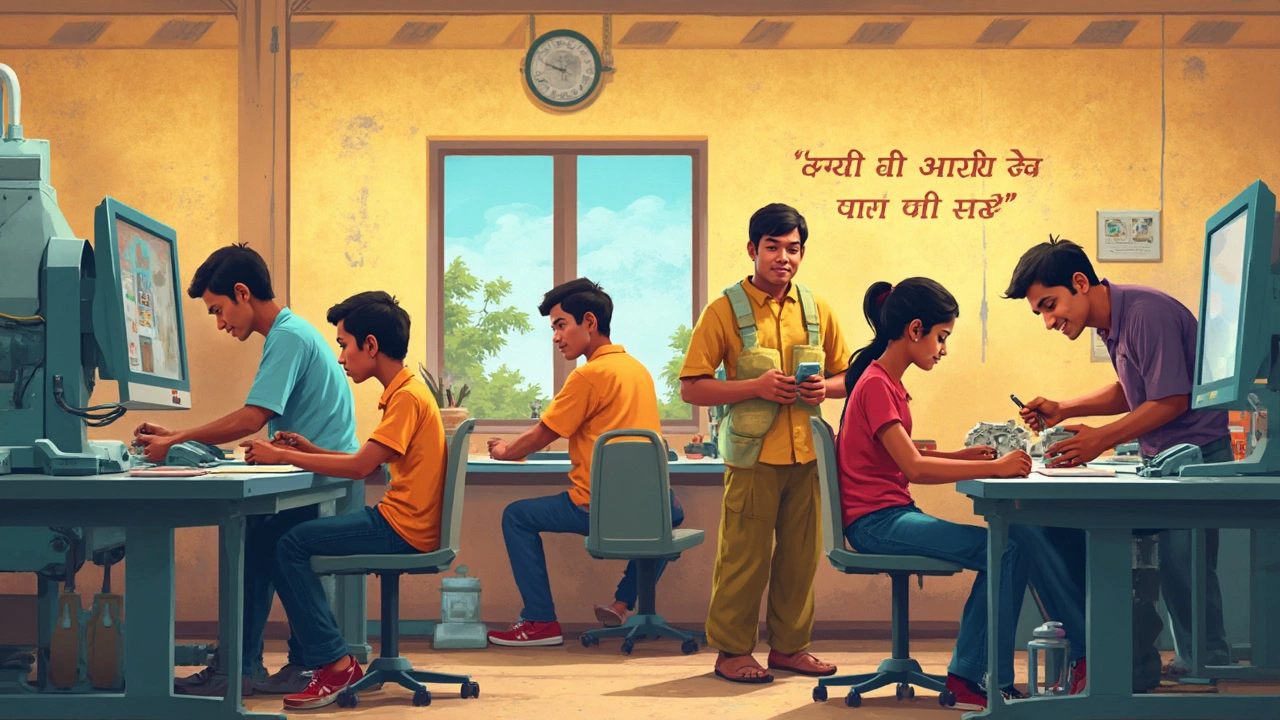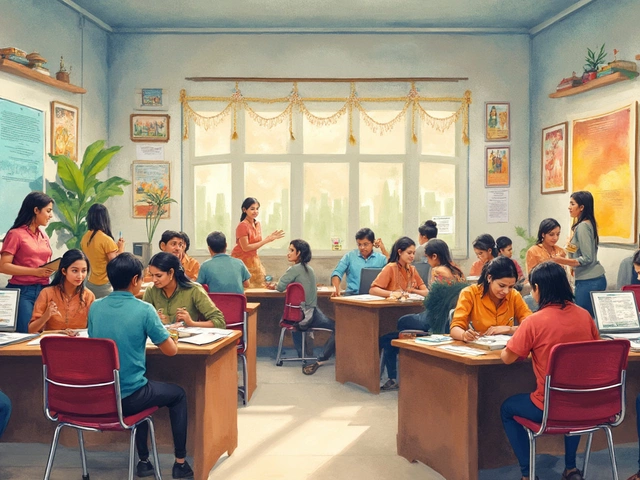
The word “vocational” gets thrown around a lot, but most people don’t really know what it means inside a school. It’s not just about shop class or learning how to fix cars, though that can be part of it. Vocational in school is all about picking up real job skills before you even graduate. It’s a path that gets your hands dirty—think culinary basics, health care, coding, even plumbing—and actually shows you how stuff works in the real world.
Here’s something surprising: students who take at least one vocational course in high school are more likely to land a job straight after graduation. That’s not some random fact—government numbers back it up. Schools are putting more energy into these programs because companies keep asking for workers who know their way around a toolbox, a kitchen, a computer, or a patient’s bedside.
So, if you’re wondering whether studying vocational courses in school makes sense, pay attention. You’re not just cutting wood or following diagrams. You’re figuring out if you like a certain job long before you need to send out your first real resume. Getting skilled now can cut years off the “searching” game later.
- Getting Real: What 'Vocational' Actually Means
- How Vocational Programs Work in Schools
- What Courses Count as Vocational?
- Vocational vs. Traditional Academics: Big Differences
- Who Should Consider Vocational School?
- Tips to Succeed in Vocational Courses
Getting Real: What 'Vocational' Actually Means
If you ask ten people what vocational courses in school mean, you’ll probably hear ten different answers. Here’s the real deal: vocational means learning in a way that’s tied directly to a job or career path. Instead of just reading textbook theories, you practice real tasks that people do at work. It’s about doing, not just knowing.
Back in the day, vocational was seen as a separate track—usually for students who weren’t into college. Now it covers way more ground and includes high-tech jobs too. In fact, by 2024, over 12 million U.S. high schoolers enrolled in vocational programs, covering fields like coding, medical assisting, culinary arts, and construction management.
What really sets vocational courses apart is a focus on hands-on skills. You do the work. You learn safety protocols, handle actual tools or software, and sometimes even work with real customers—right during school hours. Many schools partner with local companies, so students snag internships or get close-up looks at how businesses really run.
- Boosts job readiness right after graduation
- Connects you with local employers before you even finish school
- Teaches practical life skills (think budgeting, teamwork, real deadlines)
People sometimes mix up vocational schools with trade schools or community college, but vocational learning actually starts in middle and high school. It gives you a taste of what a job is like, often leading to certificates you can put on your first resume. And since employers want ready-to-work skills, these programs often set students up for faster hiring or higher starting pay straight out of school.
| Vocational Enrollment (U.S.) | Top Fields |
|---|---|
| 12+ million (2024) | Health Science, IT, Construction, Culinary |
If you’re a student who wants to skip sitting in lecture halls and get paid sooner, vocational in school isn’t just an option, it could be a smart move.
How Vocational Programs Work in Schools
So, how do vocational courses actually fit into a regular school day? Schools set these up pretty much like any other class, but there’s a twist: you do way more hands-on stuff. Instead of listening to a lecture about computer science, you’re writing real code. Rather than reading from a textbook about healthcare, you practice skills like taking blood pressure or giving a first aid response—sometimes even on simulations or mannequins.
In most high schools, students can sign up for vocational courses alongside their core subjects like math and English. Some districts even have whole campuses called career and technical education (CTE) centers, packed with legit gear—3D printers, commercial kitchens, auto bays, and even full-sized construction spaces.
Here’s what a typical vocational program might involve:
- You pick an area you’re interested in (like welding, graphic design, or culinary arts).
- You spend a big chunk of your week in dedicated classes or lab time focused on that area.
- Teachers often have real job experience in the field, not just teaching credentials.
- Many programs partner with local businesses for job shadowing, internships, or even apprenticeships—you actually get out of the classroom and try things at real workplaces.
Some schools offer industry-recognized certificates—the same ones adults use to get hired. For example, after finishing a healthcare program, you might walk out ready to take a Certified Nursing Assistant (CNA) exam. That’s a big leg up.
| Type of Program | Typical Certifications | Average Time (Years) |
|---|---|---|
| Information Technology | CompTIA, Cisco CCNA | 2 |
| Automotive Technology | ASE Entry-Level | 2 |
| Culinary Arts | ServSafe, ProStart | 1-2 |
| Nursing/Healthcare | CNA, CPR | 1-2 |
The National Center for Education Statistics said in 2023 that nearly 7.5 million students in the U.S. are enrolled in high school vocational or CTE programs. That number keeps growing every year as more students—and their parents—see the value in learning these practical skills early.
“Vocational programs bridge the gap between education and real-world jobs. Students leave ready for work or with a head start on further training.”
— Association for Career and Technical Education
The best part? You’re not boxed in if you change your mind. Taking vocational courses just gives you options—and options are never a bad thing.
What Courses Count as Vocational?
When folks talk about vocational courses in school, they mean classes where you get practical, work-ready skills—not just theory or textbooks. These aren’t your usual math or English classes. They’re more about what you’d actually do on the job, and they cover a massive range of options.
Think of stuff like:
- Automotive repair – Actually fixing cars, not just reading about engines.
- Culinary arts – Learning to cook, manage kitchens, and even handle food safety.
- Health sciences – Prepping for nursing, dental assisting, or even basic EMT training.
- Computer programming and IT tech – Building websites, keeping networks safe, and troubleshooting computers.
- Construction and carpentry – Real construction sites, building projects, power tools included.
- Welding, plumbing, and electrical trades – Yes, you really hold the tools in hand and do the work.
- Cosmetology – Hair, nails, skin, and learning what it takes to work in a salon.
- Business, marketing, and even retail management – Running mock stores, managing projects, and learning how money flows in the real world.
These classes aren’t just for show. A lot of them lead to certifications, like getting a ServSafe card from culinary arts or a CompTIA A+ cert in IT basics. Some even let you start apprenticeships while you’re still in high school.
"Vocational education offers a direct path to employment and practical life skills that traditional courses may not provide," says the Association for Career & Technical Education (ACTE). "Students graduate ready to meet employer expectations from day one."
Here’s a quick look at the kinds of vocations offered at U.S. high schools in 2024:
| Program Area | Example Careers | Percent of Schools Offering |
|---|---|---|
| Health Sciences | Nursing Assistant, Pharmacy Tech | 68% |
| Automotive | Mechanic, Technician | 55% |
| Construction Trades | Carpenter, Electrician | 44% |
| IT & Computer Science | Web Developer, IT Support | 62% |
| Culinary Arts | Chef, Restaurant Manager | 53% |
| Cosmetology | Hairdresser, Nail Tech | 31% |
It’s not just blue-collar trades these days. You’ll find vocational courses for business, digital design, even early childhood education. If you haven’t checked your school’s course list, you might be surprised by what counts as "vocational" now.

Vocational vs. Traditional Academics: Big Differences
When you look at vocational courses in school next to regular academic classes, the difference jumps out fast. In traditional academics, you’re mostly in classrooms, reading from textbooks, writing essays, and tackling algebra or history. The goal here? Passing exams and prepping for college. You hear about Shakespeare, the Civil War, and mitochondria. But sometimes, you don’t really see how any of that connects to a steady paycheck right after graduation.
Vocational courses, on the other hand, are built around doing. You move from reading about a job to actually doing that job—even if it’s just for a class project or school workshop. You might weld metal, prep mock patients, build computer networks, or even run a school bakery. Grades are often based on what you can make or fix, not just what you memorize.
Here’s a quick side-by-side breakdown:
| Traditional Academics | Vocational Courses |
|---|---|
| Focus on theory and concepts | Focus on hands-on skills |
| Exams and essays for grades | Projects and practical tasks for grades |
| Usually leads to college first | Can jump right into a career |
| Teachers with academic backgrounds | Instructors with work experience |
| Subjects: Math, literature, sciences | Subjects: Healthcare, trades, IT, hospitality |
Not everyone fits in a one-size-fits-all model. Some people hate the idea of sitting at a desk all day. They want to learn by actually doing stuff. That’s where vocational paths shine. According to the National Center for Education Statistics, students who finish high school with a vocational focus have a job placement rate over 10% higher within six months of graduation compared to those who stuck to strictly academic studies. That’s hard to ignore if you want a fast start after school.
But don’t get it twisted: vocational learning isn’t "easier." You need technical knowledge, problem-solving on the fly, and teamwork. A lot of jobs today—even in industries like healthcare and IT—want people who picked up actual skills, not just grades. When you finish a vocational course, you often walk out with a certificate, portfolio, or even industry credentials that prove you’re job-ready.
Who Should Consider Vocational School?
Not every student loves sitting in a classroom all day, soaking up theory. Vocational courses are made for people who want to learn by doing, not just reading. If you get bored with tons of writing, but you love the idea of jumping into projects—think welding, nursing, coding, or cooking—then this path will fit like a glove.
Teens who already know what career they want might actually save time and money with vocational courses. Instead of waiting four years before starting “real” training, you get right to it in high school. Some programs even let you earn licenses or certificates, so you can start working fresh out of school.
It’s not just for those who skip college. Plenty of students use vocational tracks as a springboard. Maybe you want to become an electrician and later go to college for engineering. Or you’re eyeing the health care field, so you take medical assistant classes to get started early.
Vocational school also makes sense if you want fast entry into the workforce—without mountains of student debt. According to the U.S. Department of Education,
| Path | Avg. Time to Job |
|---|---|
| Vocational Course | 0-12 months after high school |
| Traditional Degree | 2-6 years post-high school |
- If you like hands-on projects more than essays, this is for you.
- If college feels too expensive or slow, vocational programs offer a quicker way in.
- If you want work experience before you’re 20, these classes make that possible.
There’s no “one size fits all.” But if you’re eager to build, fix, create, or help—in a way that brings results you can see—then vocational courses might be your best move.
Tips to Succeed in Vocational Courses
If you picked a vocational course, you’ve already got a head start, but just showing up isn’t enough. Employers are looking for people who can actually do the job, not just talk about it. These tips can help you get the most out of your skills training and stand out, whether you’re in auto tech, culinary, or any other hands-on program.
- Ask questions—lots of them. Don’t worry about looking clueless. The more you ask, the faster you learn. Instructors love seeing students get involved, and you’ll actually remember stuff when it comes time to use it on the job.
- Practice outside of class. Most vocational courses are all about learning by doing. If you can, use school equipment before or after class, or get some hands-on practice at home. The extra time pays off.
- Get feedback and actually use it. Your teachers aren’t trying to be tough—they know what employers expect. If someone tells you how to improve, take it seriously and ask for demos if you don’t get it.
- Work on “soft skills.” Stuff like showing up on time, working in a team, and communicating clearly will get noticed. In a recent survey, over 70% of employers said they value these soft skills as much as technical ability.
- Use your network. Don’t just stick with your classmates. Talk to alumni from your program or teachers with industry contacts. About 50% of career prep students find jobs through recommendations from someone they met in training.
If you’re juggling a lot, keep track of due dates and requirements—late projects or missing gear can set you back fast. If you hit a snag, don’t ghost your instructor. Most will help you figure it out if you ask early.
| Habit | Boost to Job Placement/Success |
|---|---|
| Extra Practice | 30% higher job test scores |
| Networking | 50% more likely to land interviews |
| Feedback Use | 20% quicker skill improvement |
Bottom line? Jump in, get your hands moving, and always look for ways to learn from the pros around you. Vocational courses are meant to get you job-ready—take them seriously and they’ll open doors, sometimes faster than you’d expect.





